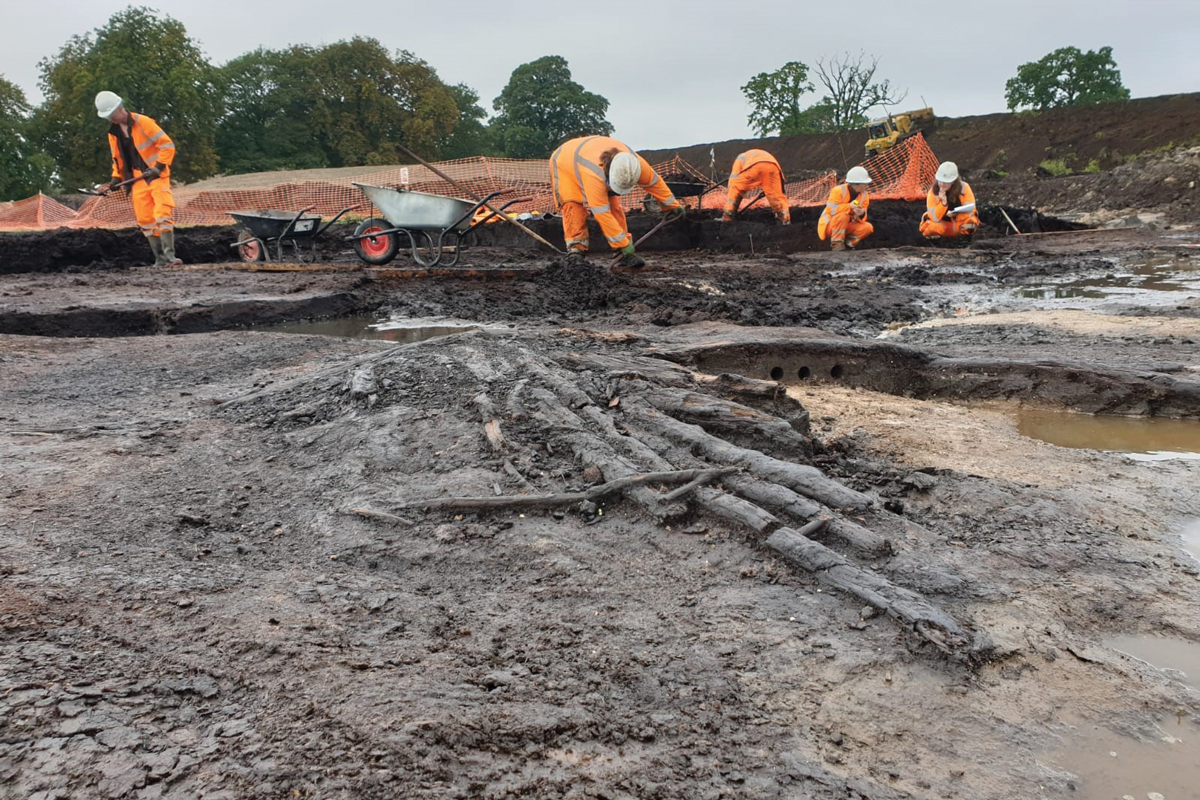Rare find puts Mesolithic timber in the frame at Tarmac quarry

First published in the May 2020 issue of Quarry Management as Can You Dig It?
Rare find puts Mesolithic timber in the frame at Tarmac quarry
Once-in-a-lifetime finds have come from a more than decade-long collaboration between Tarmac and Archaeological Research Services
It is by no means unusual for the quarrying industry to uncover something of historical interest – but it is rarer to hear the finds being described by an archaeologist as ‘unprecedented’ and which have them ‘utterly amazed’ at the spectacular level of preservation of the ancient materials revealed.
The unique findings have come about through a more than a decade-long collaboration at a quarry in North Yorkshire between an archaeology firm and leading construction materials company Tarmac.
Archaeological Research Services Ltd (ARS) have been carrying out extensive archaeological survey and excavation work since 2008 at Tarmac’s site at Killerby, on the outskirts of Northallerton, which, when the quarry begins extraction, will produce high-quality sand and gravel for use in infrastructure and construction.
The remains found are of two timber structures that have been confirmed as from the early Mesolithic (immediately after the last Ice Age), dating to 11,000 years old. One is in pristine condition and the oldest surviving example of a dwelling with its timbers preserved, as well as an internal hearth, ever found in Britain. It is amongst the best-preserved sites of this age discovered across Europe, giving it international significance.
Archaeologists have used a wide range of techniques to discover what remains of ancient hunter-gatherer groups exist at Killerby. These include desk-based research, field-walking for flint and chert tools, and targeted excavation of wetland basins to discover what archaeological and other remains survive.
The wood from the structures is so well preserved, having been trapped in peat without oxygen for thousands of years, that ARS managing director Dr Clive Waddington describes them as ‘looking like they were felled yesterday’. The poles show evidence of trimming, and marks made by stone axe-heads used to ready the timbers can still be seen.
One of the structures was made from two Y-shaped poles approximately 2.5–3.0m in length and constructed in an A-frame shape, which the archaeologists believe formed part of a structure that was built on the edge of a pond during the drier summer months. At an adjacent kettle hole a later Meoslithic timber platform was found. This is thought to have been used as a tanning pit for curing hides.
Another structure found on the edge of one of the wetlands, radiocarbon dated to around 11,000 years ago, was formed by 6–7m long poles that appear to have been used to make a cone-shaped structure. This would have been covered with reed thatch, hides or another covering, similar to a tepee, and has the remains of its last fire still present.
In addition to taking core samples to analyse layers, the team systematically sample the excavated wetland, an approach not used before on such a site. ‘We’re really pleased that this approach, which was carefully devised with Tarmac, has paid off and is significant in that it might also influence how other programmes of evaluation and excavation are conducted in future,’ said Clive Waddington.
The site has also yielded several Romano-British farmstead enclosures which have produced quantities of grain and a quernstone (or millstone), together with a trackway leading to a wetland where thousands of butchered animal bones have been recovered. The current belief is that the site was a key part of the supply network for the nearby Roman town and garrison of Catterick, a couple of kilometres away.
Archaeologists on site have also discovered various other remains from the Mesolithic era (9,700 BC–4,000 BC) to the Romano-British period (43 AD–410 AD), including rare flint arrowheads, axe-heads, knives and scraping tools.
Alan Coe, production manager for North Yorkshire at Tarmac’s Killerby Quarry, said: ‘We’re very excited by these findings. It’s extremely important that items of historic interest are catalogued and thoroughly researched during our preparatory work, so they can be recorded and the information shared with the public. Without this work being carried out at the quarry, findings such as these would have never seen the light of day.’
With mineral extraction essential to the UK’s infrastructure pipeline, the work is part of Tarmac’s commitment across all their sites to document finds and ensure they are managed responsibly and sustainably to help conserve and enhance natural habitats, wildlife and cultural heritage. The company also shares this work with the public, and in 2019 Tarmac held an archaeological open day for the public to highlight some of the historical artefacts that have been discovered.
There are plans to carry out further analysis to help understand more about what went on at the site, including analysis of the material in the hearth pit and a cluster of pit features around the edge of another wetland.
Clive Waddington added: ‘We’ve undertaken precise dating of the Mesolithic buildings and will be analysing the material from the hearth pit to tell us what kind of activities were taking place, what food people were eating, and what time of year the site was occupied.
‘We’re still in the process of understanding whether this could have formed part of an ancient seasonal camp or whether it relates to some other form of activity, but a settlement site seems most likely at the moment.’
Once Tarmac’s Killerby Quarry is operational, it will cover around 120ha of undulating ground – landforms that were mainly laid down during the end of the Ice Age, along with an area of riverbed floodplain.
Working closely with Tarmac, archaeologists ARS are continuing investigations around the quarry following their success so far, to see what other windows into the past the site might reveal. For more information visit: www.archaeologicalresearchservices.com/projects/killerby-quarry
- Subscribe to Quarry Management, the monthly journal for the mineral products industry, to read articles before they appear on Agg-Net.com








